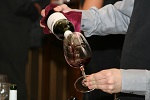
Is nothing sacred? A new report by scientists at the U.S. National Institute of Standards and Technology describes the development of a new artificial intelligence (AI) technology that accurately judges wine. Sacre bleu! - a French connoisseur would turn over in their grave!
AI technologies have been developing rapidly, providing new and useful approaches to banking, investing and even medicine. Recently, we wrote about AI-assisted screening for cancerous cells in tissue samples. I heard a colleague describe an AI-assisted pap smear screening procedure that handled hundreds or thousands of samples per hour. AI also enhanced colonoscopy screening efficiency by 30%. AI is entering all sectors of our lives.
But replacing sommeliers and other wine professionals may be a step too far. A sommelier is highly trained to evaluate wines and select just the right pairing to help you enjoy that special meal. The elite among this group are those that hold a Master Sommelier diploma. They know the flavors that are present and how they combine and enhance each other to provide outstanding flavor in your favorite wine.
I bet many of you have visited vineyards for a wine tasting. If you haven't, it's a great experience where the vineyard sommelier guides you through their best wines and explains what makes them good. They talk about the fruit level, sweetness, the body profile and of course the finish. Needless to say, the flavors and characteristics of wine are complex.
The five main defining characteristics of wine are: sweetness, acidity, tannin, alcohol and body. Sweetness is the amount of sugars present in the wine. Even some dry wines have residual sugar content. Tannin contributes bitterness to the wine. This comes from organic compounds involving a mixture of flavor chemicals called polyphenols that are present. This contributes that lingering dry and slightly bitter taste you get after you swallow. Acidity is that zesty and tart taste. Flavor is judged by the types of fruit you taste - like blueberry, peach or citrus. Body is the overall impression of the wine and includes the level of alcohol present and how long the flavor lingers. I can taste my favorite Merlot now!
This new research first trained the AI by using almost 150 wines originating from three grape varieties. The wines came from an established dataset of different wines. The scientists considered 13 traits that were easily measured with laboratory equipment like color, alcohol level, acidity, and magnesium. These traits contributed to the five main characteristics mentioned above. Each trait was given a value between zero and one and once assembled, this system discriminated between the different wines.
After the scientists trained the AI, they tested 30 more wines and the AI system made only two mistakes. Before you start looking for your AI Sommelier, this technology remains in the realm of sophisticated and expensive technology for now. But innovation will likely bring this to your pocket in the future. When chemistry and physics meet good taste, everybody wins.
More Information
AI gets 95 percent on wine tasting test
Scientists at NIST in the US are developing new ways to train AI and have tested it by subjecting it to a complex wine exam, which it passed with flying colours...
Implementation of a Binary Neural Network on a Passive Array of Magnetic Tunnel Junctions
The increasing scale of neural networks and their growing application space have produced demand for more energy- and memory-efficient artificial-intelligence-specific hardware. Avenues to mitigate the main issue, the von Neumann bottleneck, include in-memory and near-memory architectures, as well as algorithmic approaches. Here we leverage the low-power and the inherently binary operation of magnetic tunnel junctions (MTJs) to demonstrate neural network hardware inference based on passive arrays of MTJs. In general, transferring a trained network model to hardware for inference is confronted by degradation in performance due to device-to-device variations, write errors, parasitic resistance, and nonidealities in the substrate...